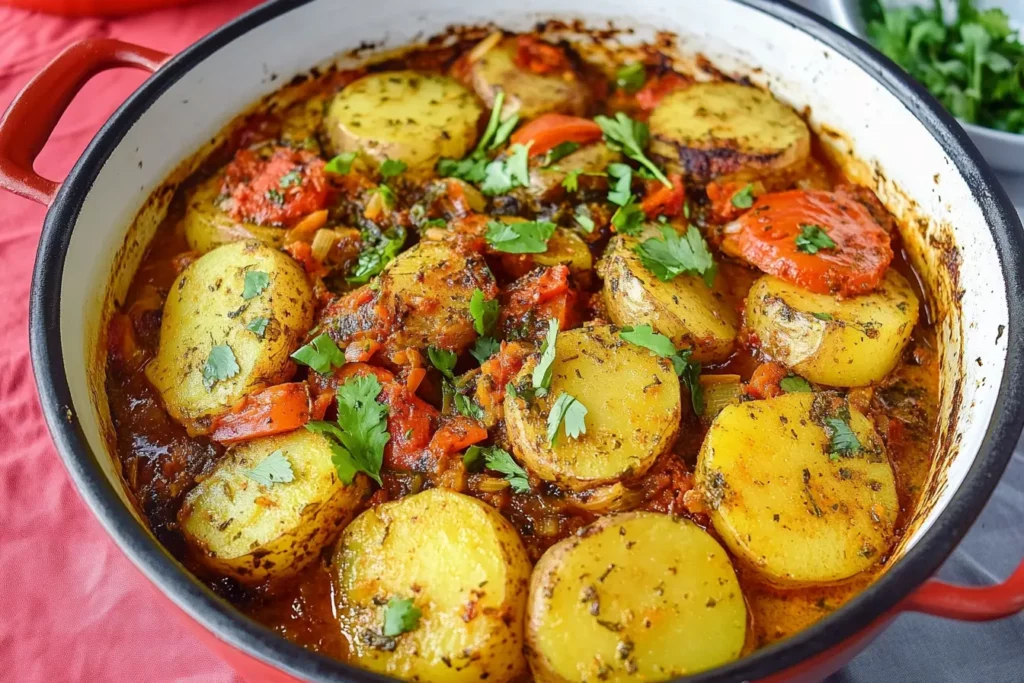🖋️ Written by Emma
Potato Tagine is a delicious and aromatic Moroccan dish known for its rich spices, tender potatoes, and slow-cooked perfection. This traditional meal is a staple in North African cuisine, offering a comforting and flavorful experience with every bite. Whether prepared in a classic clay tagine or a regular pot, the slow-simmering process ensures that the ingredients absorb the bold flavors of cumin, turmeric, and paprika.
If you’ve ever wanted to master the art of making an authentic Potato Tagine, you’re in the right place. In this guide, we’ll reveal the essential ingredients, cooking techniques, and secret tips to create the most flavorful version of this Moroccan favorite. Let’s get started!
What Makes Potato Tagine So Special?
The Unique Flavors of Potato Tagine
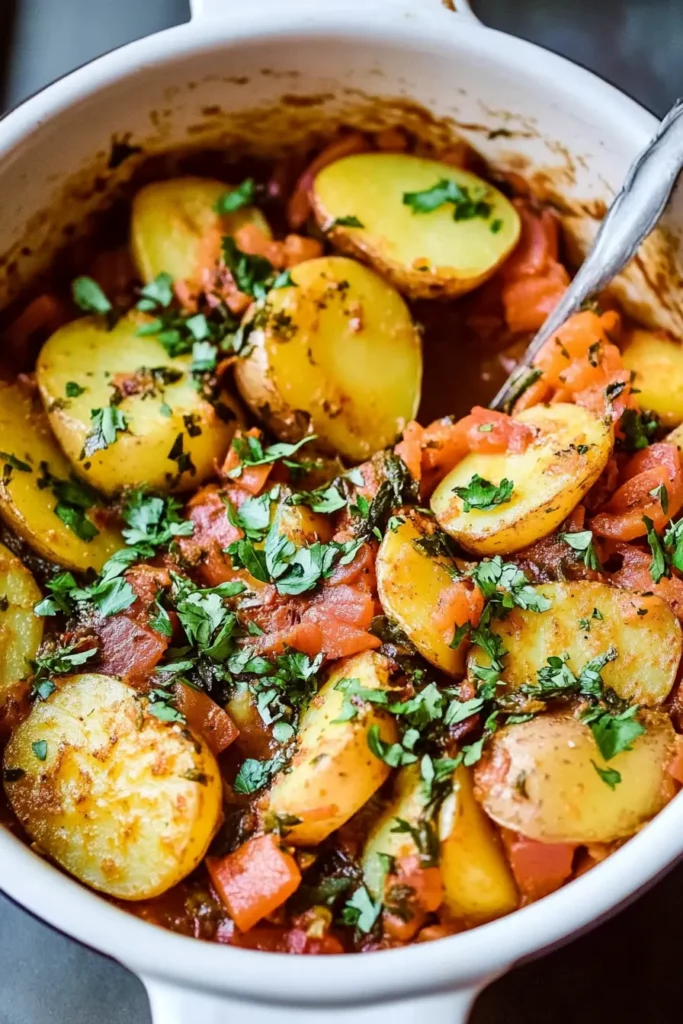
Potato Tagine is more than just a simple potato dish—it’s a slow-cooked Moroccan masterpiece bursting with warm spices and deep, rich flavors. What makes this dish truly special is its ability to transform basic ingredients like potatoes, onions, and tomatoes into a comforting and aromatic meal. The combination of earthy cumin, smoky paprika, and golden turmeric creates a complex and irresistible taste.
A Dish Rooted in Moroccan Tradition
In Moroccan households, Potato Tagine is not just food—it’s a symbol of togetherness and tradition. This dish is commonly served at family gatherings, often accompanied by fresh bread to soak up the flavorful sauce. The slow-cooking technique used in a tagine pot allows the ingredients to blend beautifully, enhancing their natural sweetness and depth.
Why Slow Cooking is Essential
One of the key secrets behind a perfect Potato Tagine is the slow-cooking process. Instead of boiling the ingredients quickly, the dish is gently simmered, allowing the spices to infuse deeply into the potatoes. This method not only enhances the taste but also preserves the texture, keeping the potatoes soft yet intact.
As we move forward, we’ll explore the essential ingredients that bring this dish to life and how to choose the best ones for the most flavorful Potato Tagine!
Essential Ingredients for the Perfect Potato Tagine
The Key Ingredients That Define Potato Tagine
A truly delicious Potato Tagine starts with a handful of fresh, flavorful ingredients that come together to create a rich and satisfying dish. While variations exist, the foundation of this Moroccan specialty remains the same, ensuring an authentic taste and texture in every bite.
Must-Have Ingredients for an Authentic Potato Tagine
Here are the essential ingredients that give Potato Tagine its bold flavors and traditional appeal:
- Potatoes – The heart of the dish, absorbing all the fragrant spices.
- Olive Oil – Adds richness and enhances the depth of flavor.
- Onions & Garlic – A flavorful base that brings natural sweetness.
- Tomatoes – Provide a subtle tanginess that balances the dish.
- Spices (Cumin, Turmeric, Paprika, Cinnamon) – The soul of Moroccan cuisine, creating warmth and complexity.
- Fresh Herbs (Parsley & Cilantro) – Add a fresh, vibrant finish.
- Olives & Preserved Lemons (Optional) – Classic Moroccan additions for a bold, tangy contrast.
The Role of Spices in Potato Tagine
Moroccan cuisine is famous for its rich spice blends, and Potato Tagine is no exception. Cumin and paprika add warmth, turmeric brings color and depth, and cinnamon offers a subtle sweetness. Together, these spices create the signature taste that makes this dish stand out.
Why Ingredient Quality Matters
For the best results, always choose fresh, organic vegetables and high-quality olive oil. The better the ingredients, the more flavorful and authentic your Potato Tagine will be.
Now that we’ve covered the key ingredients, let’s dive into the best cooking techniques to bring out the full potential of this Moroccan classic!
The Best Cooking Techniques for a Perfect Potato Tagine
Mastering the Slow-Cooking Method
A key secret to making an authentic Potato Tagine is the slow-cooking process. Unlike quick stovetop meals, this method allows the flavors to develop gradually, ensuring that the potatoes soak up the rich blend of Moroccan spices while remaining tender yet firm. The slow simmering technique creates a deep, satisfying taste that sets this dish apart from ordinary stews.
Should You Use a Traditional Tagine or a Regular Pot?
While a clay tagine pot is ideal for cooking Potato Tagine, you can also use a Dutch oven or a heavy-bottomed pot if you don’t have one. The key is maintaining gentle heat to allow slow, even cooking, which enhances flavor and texture.
Step-by-Step Guide to Cooking Potato Tagine
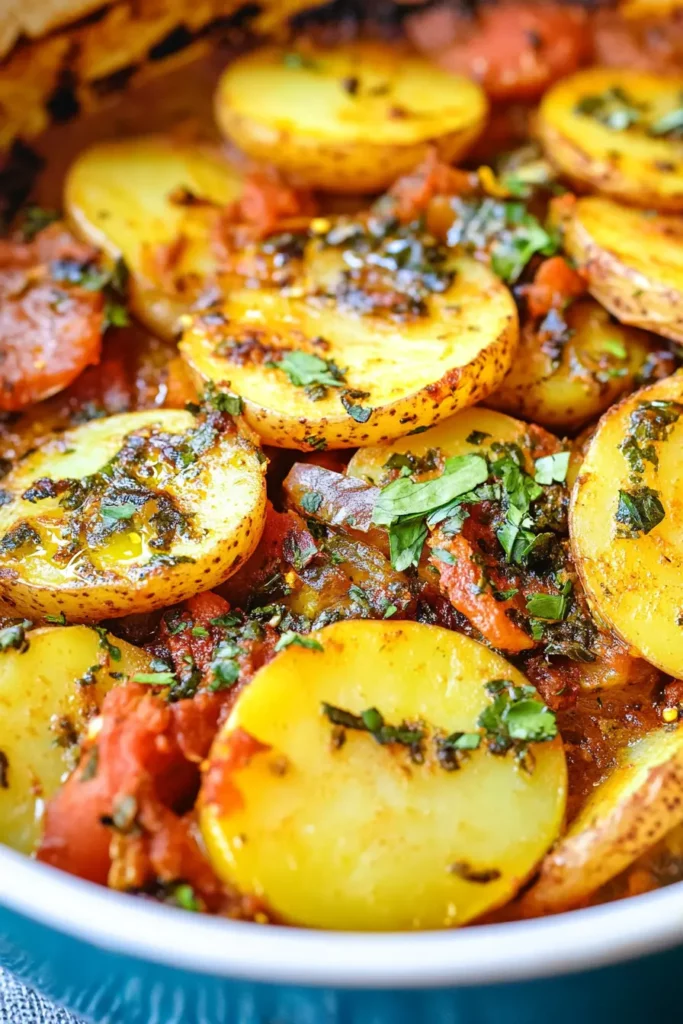
- Heat olive oil in a tagine or deep pan over low heat.
- Sauté onions and garlic until they become soft and fragrant.
- Add diced potatoes, tomatoes, and Moroccan spices, stirring to coat evenly.
- Pour in a small amount of water to create steam and help with slow cooking.
- Cover and simmer for about 40-50 minutes, allowing the flavors to blend.
- Garnish with fresh herbs and olives before serving.
Why Slow Cooking Enhances the Flavor
Cooking Potato Tagine at a low temperature allows the spices to fully infuse into the ingredients, creating a well-balanced and rich taste. The moisture trapped inside the pot keeps the dish moist and flavorful, without the need for excessive liquid.
Now that you know the best cooking techniques, let’s explore the essential Moroccan spice blends that take Potato Tagine to the next level!
The Essential Spices That Elevate Potato Tagine
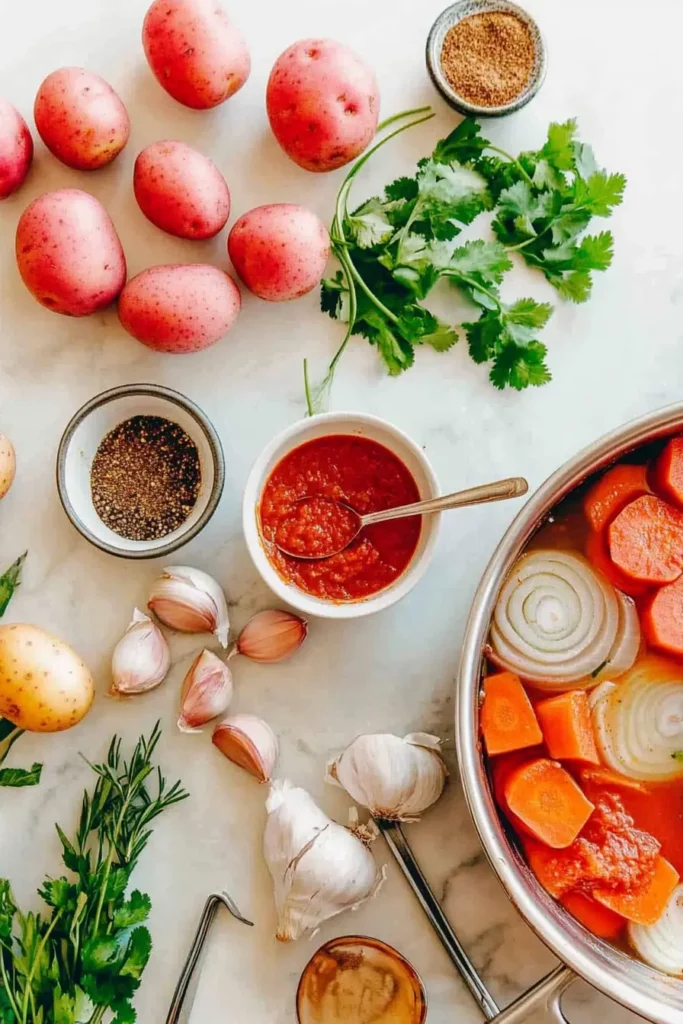
Why Spices Are the Heart of Potato Tagine
One of the key reasons Potato Tagine stands out in Moroccan cuisine is its bold and aromatic spice blend. The right combination of warm, earthy, and slightly sweet spices creates the deep flavors that define this dish. Without them, the tagine would lack its signature richness and complexity.
The Must-Have Spices for Authentic Flavor
Here are the essential Moroccan spices that bring Potato Tagine to life:
- Cumin – Adds an earthy, slightly nutty flavor.
- Turmeric – Provides a warm, golden color and mild bitterness.
- Paprika – Gives a subtle smokiness and a touch of sweetness.
- Cinnamon – A surprising ingredient that enhances depth and aroma.
- Ginger – Offers a slight heat and peppery taste.
- Coriander – Balances the dish with citrusy and floral notes.
- Black Pepper – Adds a hint of sharpness and spice.
How to Get the Perfect Spice Balance
The key to a great Potato Tagine is finding the right balance of spices. Too much of one spice can overpower the dish, while too little can leave it tasting flat. A well-balanced blend ensures that every bite is rich, flavorful, and aromatic.
Pre-Mixed Moroccan Spice Blends for Convenience
If you prefer an easier option, you can use Ras el Hanout, a traditional Moroccan spice mix that combines many of these flavors into one. This blend adds depth and authenticity to your tagine without needing to measure each spice individually.
Now that we’ve covered the essential spices, let’s move on to the cooking methods and whether you should use a stovetop, oven, or traditional clay pot for the best results!
Should You Cook Potato Tagine on the Stovetop or in the Oven?
Traditional Cooking Methods for Potato Tagine
Cooking Potato Tagine the right way is just as important as using the correct ingredients and spices. Traditionally, this dish is slow-cooked in a clay tagine pot over low heat, allowing the flavors to develop gradually. However, modern kitchens offer multiple ways to prepare it, whether on the stovetop, in the oven, or even in a slow cooker.
Stovetop vs. Oven: Which Method is Best?
Both stovetop and oven cooking can produce a delicious Potato Tagine, but each has its own benefits:
| Cooking Method | Pros | Cons |
|---|---|---|
| Stovetop (Traditional Method) | Authentic flavor, slow infusion of spices, retains moisture | Requires a heat diffuser to prevent cracking in clay tagines |
| Oven Cooking | Even heat distribution, less supervision needed | May dry out the dish if not covered properly |
| Slow Cooker | Set-and-forget convenience, great for busy cooks | Lacks the same depth of flavor as slow simmering in a tagine |
How to Cook Potato Tagine on the Stovetop
- Heat olive oil in a tagine or heavy-bottomed pot over low heat.
- Sauté onions and garlic until golden and fragrant.
- Add potatoes, tomatoes, and spices, stirring to coat evenly.
- Pour in a small amount of water, cover, and let it simmer on low heat for 40-50 minutes.
- Garnish with fresh herbs and olives, then serve hot with Moroccan bread.
How to Cook Potato Tagine in the Oven
- Preheat the oven to 325°F (160°C).
- In an oven-safe tagine or Dutch oven, layer the potatoes, onions, tomatoes, and spices.
- Drizzle with olive oil and add a small amount of water.
- Cover with a lid and bake for 1 to 1.5 hours, checking occasionally to prevent drying.
- Remove from the oven, garnish with fresh herbs, and serve warm.
Which Cooking Method Should You Choose?
If you’re looking for authenticity, the stovetop method using a traditional clay tagine is the best choice. However, if you prefer a more hands-off approach, the oven method works well, provided you cover the dish properly to retain moisture.
Now that you know the best cooking methods, let’s dive into another important aspect—whether or not you need to soak your tagine pot before cooking!
Do You Need to Soak Your Tagine Before Cooking?
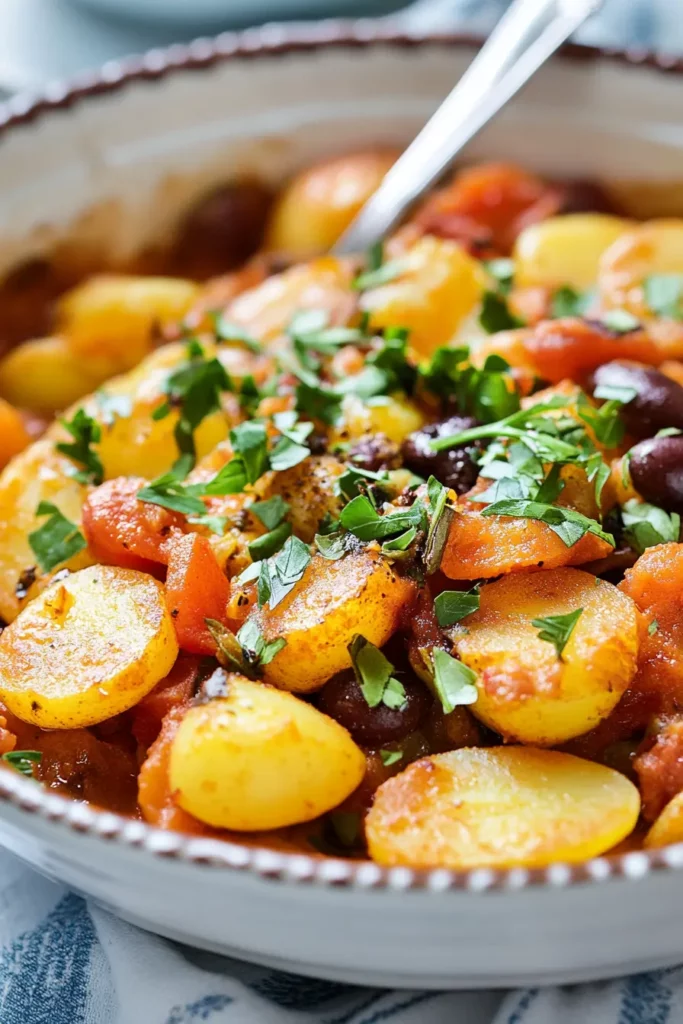
Why Soaking a Tagine is Important
If you’re using a traditional clay tagine to cook your Potato Tagine, it’s essential to soak it before first use. Clay tagines are porous, meaning they can crack under sudden heat if not properly prepared. Soaking strengthens the pot, preventing it from breaking and ensuring even heat distribution for slow cooking.
When and How to Soak Your Tagine
Soaking is only necessary for unglazed clay tagines. If you have a ceramic or glazed tagine, soaking is usually not required. Follow these simple steps to prepare your tagine for cooking:
- Fill the base and lid with water and let it soak for at least 24 hours before first use.
- Drain the water and let the tagine air-dry completely.
- Rub the inside with olive oil to season it, which helps create a natural non-stick surface.
- Place the tagine in a cold oven, set the temperature to 300°F (150°C), and let it bake for 2 hours to strengthen the clay.
- Turn off the oven and let the tagine cool down inside before removing it.
Do You Need to Soak a Tagine Every Time?
No, you only need to soak your tagine before the first use. However, if you don’t use it frequently, a quick 30-minute soak before cooking can help maintain the clay’s durability.
How to Care for Your Tagine After Cooking
- Always wash by hand with mild soap (avoid dishwashers).
- Let it cool completely before washing to prevent thermal shock.
- Store in a dry place to avoid moisture buildup.
Properly seasoning and caring for your tagine will help it last for years, ensuring you can enjoy delicious Potato Tagine and other Moroccan dishes without worry.
In the next section, we’ll discuss another common question—should you cook your tagine on the stovetop or in the oven?
Can You Cook Potato Tagine on the Stovetop or in the Oven?
Understanding the Best Cooking Method for Potato Tagine
One of the most common questions about making Potato Tagine is whether it should be cooked on the stovetop or in the oven. Traditionally, tagines are slow-cooked over low heat on the stovetop, but modern adaptations allow for oven cooking as well. Each method has its own benefits, depending on the equipment you have and the level of convenience you prefer.
Stovetop Cooking: The Traditional Method
Cooking Potato Tagine on the stovetop allows for authentic slow simmering, where the flavors develop gradually. This method is best if you have a traditional clay tagine or a heavy-bottomed pot.
How to Cook Potato Tagine on the Stovetop:
- Place your tagine on a heat diffuser over low heat to prevent cracking.
- Add olive oil, onions, and garlic, then sauté until fragrant.
- Layer potatoes, tomatoes, and spices, coating everything evenly.
- Pour in a small amount of water to create steam.
- Cover and simmer on low heat for 40-50 minutes, stirring occasionally.
- Garnish with fresh herbs and olives before serving.
Oven Cooking: A Convenient Alternative
If you don’t have a stovetop-safe tagine or prefer a hands-off approach, baking your Potato Tagine in the oven is a great alternative. This method distributes heat more evenly and requires less monitoring.
How to Cook Potato Tagine in the Oven:
- Preheat the oven to 325°F (160°C).
- In an oven-safe tagine or Dutch oven, layer potatoes, onions, and tomatoes with olive oil and spices.
- Add a small amount of water, then cover with a lid.
- Bake for 1 to 1.5 hours, checking occasionally to prevent drying.
- Remove from the oven, garnish with fresh herbs, and serve warm.
Which Cooking Method is Better?
| Method | Pros | Cons |
|---|---|---|
| Stovetop | Traditional, deep flavors, slow infusion of spices | Requires careful heat control and a heat diffuser for clay tagines |
| Oven | Even heat distribution, less supervision | Can dry out if not covered properly |
Both methods can produce a delicious, flavorful Potato Tagine, so it ultimately depends on your cooking preference and available equipment.
Now that you know how to cook it, let’s move on to the final steps—how to serve and enjoy your Moroccan Potato Tagine!
How to Serve and Enjoy Potato Tagine
The Best Way to Serve Potato Tagine
Once your Potato Tagine is perfectly cooked, it’s time to serve it the traditional Moroccan way. Tagines are more than just a meal—they are a communal experience, meant to be shared with family and friends. Unlike Western meals that rely on individual plates, a tagine is often placed in the center of the table, allowing everyone to enjoy it together.
What to Serve with Potato Tagine
To make your meal truly authentic, pair your Potato Tagine with these traditional Moroccan sides:
- Moroccan Bread (Khobz) – Perfect for scooping up the flavorful sauce.
- Couscous – A light, fluffy grain that complements the rich, spiced potatoes.
- Olives and Preserved Lemons – Classic Moroccan accompaniments that add a tangy contrast.
- Fresh Salads – Such as Moroccan carrot salad or a refreshing cucumber and tomato mix.
How to Eat Potato Tagine the Moroccan Way
- Traditionally, Moroccans eat tagine with their hands, using pieces of bread to scoop up the potatoes and sauce.
- If you prefer, you can serve it on plates, but for the full experience, try eating directly from the communal dish with friends and family.
Adding a Final Touch for Extra Flavor
For an even richer taste, consider adding these finishing touches before serving:
✔ A drizzle of extra virgin olive oil for added richness.
✔ A sprinkle of fresh parsley or cilantro for color and freshness.
✔ A squeeze of lemon juice to enhance the flavors.
How to Store and Reheat Leftovers
If you have leftovers, don’t worry—Potato Tagine tastes even better the next day as the flavors continue to develop!
- Storage: Keep in an airtight container in the refrigerator for up to 3 days.
- Reheating: Warm it slowly on the stovetop over low heat, adding a splash of water if needed.
Now that you know how to serve and enjoy Potato Tagine, let’s answer some common FAQs to help you perfect this dish!
Frequently Asked Questions About Potato Tagine
What is a Tagine?
A tagine is both a North African cooking vessel and the dish itself. The pot is made of clay or ceramic with a cone-shaped lid that helps trap steam, allowing food to cook slowly and develop rich flavors. The dish, such as Potato Tagine, is a slow-cooked Moroccan stew infused with warm spices.
Why Is This Recipe a Keeper?
This Potato Tagine recipe is a must-try because it’s:
✔ Healthy – Packed with vegetables and wholesome ingredients.
✔ Easy to Make – Uses simple steps and minimal prep work.
✔ Authentic – Captures the true essence of Moroccan flavors.
✔ Vegan-Friendly – A great plant-based meal option.
How to Make This Moroccan Potato Tagine?
To make Potato Tagine, you’ll need potatoes, tomatoes, onions, garlic, olive oil, and Moroccan spices. The ingredients are slow-cooked in a tagine or pot until the flavors are fully developed. For a step-by-step guide, check out Part 8 of this article!
What Are the Basic Spices for Tagine?
The most common spices in Potato Tagine include:
Cumin – Earthy and warm.
Turmeric – Adds color and mild bitterness.
Paprika – Slightly sweet and smoky.
Cinnamon – Enhances depth and aroma.
Ginger & Coriander – Provide a bright, slightly spicy kick.
Do I Need to Soak My Tagine Before Cooking?
If you’re using a traditional clay tagine, you must soak it in water for 24 hours before first use to prevent cracking. Glazed ceramic tagines do not require soaking.
Does a Tagine Go in the Oven or on the Hob?
Both methods work! Potato Tagine can be slow-cooked on the stovetop (the traditional method) or baked in the oven for even heat distribution. Just make sure to use low heat and a heat diffuser if cooking on the stovetop.
How Can I Customize My Potato Tagine?
You can make this dish your own by adding:
✔ Chickpeas for extra protein.
✔ Carrots or zucchini for more vegetables.
✔ Olives & preserved lemons for a tangy kick.
✔ Harissa or chili flakes for spice lovers.
Final thoughts
Potato Tagine is a comforting and flavorful dish that brings the essence of Moroccan cuisine to your table. Whether you’re cooking it in a traditional tagine or a regular pot, this slow-cooked masterpiece is guaranteed to impress with its rich flavors and aromatic spices.
Now that you know all the secrets to making the best Potato Tagine, it’s time to gather your ingredients and start cooking! Enjoy this dish the Moroccan way, served with fresh bread and shared with loved ones.
Let us know in the comments—how do you like to customize your Potato Tagine?
For more creative baking inspiration and marketing ideas, explore the Facebook
